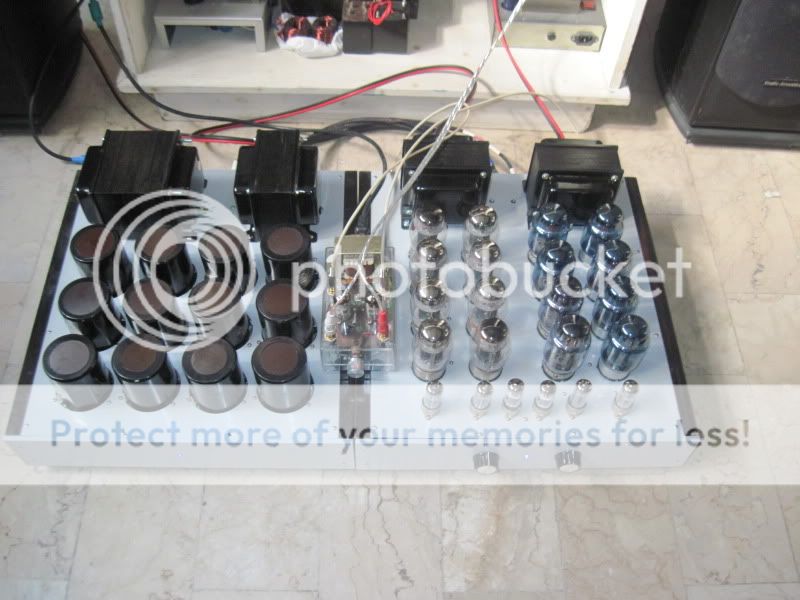I concur.............
It's the current (running through the spakers)...............
I understand your explanation (PSU current modulated by the
ampflifier), ...................
The amplifier modulates the PSU current to become the signal current.
This is wrong.We also need to mention, that this anyway is a different thing on
Class A amps, where current is approximately constant..
Even ClassA amplifier, except for a very few exceptions, do not have constant current on the supply rails.
The ClassA amplifier modulates the PSU current to become the signal.
One applies a voltage to the load. The load demands a current and that current comes from the PSU.
When the signal voltage changes the load demands a changed current. That current still comes for the PSU.
The CURRENT out of the psu IS the signal current.
Crown Grounded Bridge inherently cancels ripple injection. And a single 6300uf cap used on a bridge is equivalent to two 25200's on split rails driving parallel amplifier channels. From a ripple voltage/current standpoint.
Another thing that's counter-intuitive about the whole ripple current capacitor thing is that using a transformer with poorer regulation actually helps get the ripple down. The leakage reactance makes it work like an LC filter which increases the condution angle of the rectifier, reducing ripple voltage to values much less than the simple I=C*dv/dt would suggest. Of course, the DC regulation is poorer but you can get a cleaner supply with less capacitance.
Another thing that's counter-intuitive about the whole ripple current capacitor thing is that using a transformer with poorer regulation actually helps get the ripple down. The leakage reactance makes it work like an LC filter which increases the condution angle of the rectifier, reducing ripple voltage to values much less than the simple I=C*dv/dt would suggest. Of course, the DC regulation is poorer but you can get a cleaner supply with less capacitance.
Aaah! You've got me doing it!
OK, impulse. It requires exactly the same impulse to increment velocity regardless of velocity. But impulse is the childhood experience of work, effort applied for a time, not force * distance.
OK, impulse. It requires exactly the same impulse to increment velocity regardless of velocity. But impulse is the childhood experience of work, effort applied for a time, not force * distance.
Let's say we have a constant force. Constant force equals constant acceleration. Work equals force times distance. The faster you go the more distance you cover per second means more work per second means more power. Eg. The force that accelerates a car is proportional to the torque on the wheels. At higher speeds the rpms are higher, so if the torque (force) is the same than the power is higher. (Power is rpm times torque).
Now the trick question. If a rocket has a constant thrust (force) how does it increase power at higher speeds?
Now the trick question. If a rocket has a constant thrust (force) how does it increase power at higher speeds?
It's not constant thrust.Let's say we have a constant force. Constant force equals constant acceleration. Work equals force times distance. The faster you go the more distance you cover per second means more work per second means more power. Eg. The force that accelerates a car is proportional to the torque on the wheels. At higher speeds the rpms are higher, so if the torque (force) is the same than the power is higher. (Power is rpm times torque).
Now the trick question. If a rocket has a constant thrust (force) how does it increase power at higher speeds?
It's pressure inside the combustion chamber and that pressure is related to the speed that the combustion gases exit the chamber.
Thrust = pressure times exit area.
The Newtonian kinetic energy of a moving body is 1/2 x Mass x V^2.
Since this is nonlinear with velocity, it does indeed take more energy to accelerate a body by 1m/sec at higher speeds, than at lower speeds.
The momentum does increase linearly with velocity, but not the energy.
For example: to go from 0 to 1 m/s we need to supply (1/2 M x 1^2), or (1/2 M x 1) units of energy.
To go from 1 m/s to 2 m/s we must supply an additional amount of energy equal to: (1/2 M x 2^2) - (1/2 M x 1^2), or 1/2 M x 3 units of energy.
In fact, the energy difference required to increase the velocity by 1 m/s steps, as we go up from zero velocity,
is proportional to the sequence of odd numbers, 1, 3, 5, 7, 9, 11, without limit.
We are subtracting the squares of two adjacent integers, and the difference grows with the size of the integers.
Sorry rayma, you are of course perfectly correct, I should have said:-
'It takes exactly the same force applied for the same amount of time to accelerate a given mass from 1 m/S to 2 m/S as it does the same mass from 0 m/S to 1 m/S.'
The work or energy involved depends on the initial speed, which affects the distance through which the force acts.
It's not constant thrust.
It's pressure inside the combustion chamber and that pressure is related to the speed that the combustion gases exit the chamber.
Thrust = pressure times exit area.
So how does it change with time?
So how does it change with time?
NASA take note. We are on our way to becoming Rocket Scientists.
- Status
- Not open for further replies.
- Home
- Amplifiers
- Solid State
- How important are large filter caps for an amplifier?

